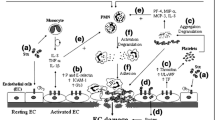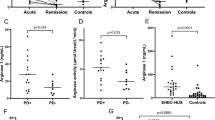Abstract
Objectives
Interleukin (IL)-33 plays an important role in host defense, immune regulation, and inflammation. This study assessed IL-33’s role in the pathogenesis of severe hemolytic uremic syndrome (HUS) induced by enterohemorrhagic Escherichia coli (EHEC). We also investigated the clinical significance of IL-33 and soluble ST2 (soluble form of IL-33 receptor) serum levels in patients with EHEC-induced HUS.
Methods
The role of IL-33 in Shiga toxin (STx)-2-induced endothelial injury was studied in human umbilical vein endothelial cells (HUVECs) in vitro. Blood samples were obtained from 21 HUS patients and 15 healthy controls (HC). The IL-33 and sST2 serum levels were quantified using an enzyme-linked immunosorbent assay. The results were compared to HUS’ clinical features.
Results
Cytotoxic assays indicated that IL-33 enhanced STx2 toxicity in HUVECs. Serum IL-33 levels in most HUS patients were below the lowest detection limit. On the other hand, serum sST2 levels in patients during the HUS phase were significantly higher than those in HC and showed a correlation with disease severity. Serum sST2 levels in patients with encephalopathy were significantly higher than those in patients without it. A serum sST2 level > 63.2 pg/mL was associated with a high risk of encephalopathy. Serum sST2 levels significantly correlated with serum levels of inflammatory cytokines related to the development of HUS.
Conclusions
Our results indicate that IL-33 contributes to the severity of EHEC-induced HUS. Serum sST2 level in HUS patients correlated with disease activity, which suggests its potential role as a marker for disease activity and development of encephalopathy in patients with EHEC-induced HUS.




Similar content being viewed by others
References
Zoja C, Buelli S, Morigi M. Shiga toxin-associated hemolytic uremic syndrome: pathophysiology of endothelial dysfunction. Pediatr Nephrol. 2010;25:2231–40.
Scheiring J, Andreoli SP, Zimmerhackl LB. Treatment and outcome of Shiga toxin-associated hemolytic uremic syndrome (HUS). Pediatr Nephrol. 2008;23:1749–60.
Hahn JS, Havens PL, Higgins JJ, O’Rourke PP, Estroff JA, Strand R. Neurological complications of hemolytic-uremic syndrome. J Child Neurol. 1989;4:108–13.
Siegler RL. Spectrum of extrarenal involvement in postdiarrheal hemolytic-uremic syndrome. J Pediatr. 1994;125:511–8.
Shiraishi M, Ichiyama T, Matsushige T, Iwaki T, Iyoda K, Fukuda K, et al. Soluble tumor necrosis factor receptor 1 and tissue inhibitor of metalloproteinase-1 in hemolytic uremic syndrome with encephalopathy. J Neuroimmunol. 2008;196:147–52.
Shimizu M, Kuroda M, Sakashita N, Konishi M, Kaneda H, Igarashi N, et al. Cytokine profiles of patients with enterohemorrhagic Escherichia coli O111-induced hemolytic-uremic syndrome. Cytokine. 2012;60:694–700.
Shimizu M, Kuroda M, Inoue N, Konishi M, Igarashi N, Taneichi H, et al. Extensive serum biomarker analysis in patients with enterohemorrhagic Escherichia coli O111-induced hemolytic-uremic syndrome. Cytokine. 2014;66:1–6.
Shimizu M, Inoue N, Kuroda M, Mizuta M, Sugimoto N, Kaneda H, et al. Angiopoietin-1 and -2 as markers for disease severity in hemolytic uremic syndrome induced by enterohemorrhagic Escherichia coli. Clin Exp Nephrol. 2017;21:76–82.
Garlanda C, Dinarello CA, Mantovani A. The interleukin-1 family: back to the future. Immunity. 2013;39:1003–18.
Cayrol C, Girard JP. IL-33: an alarmin cytokine with crucial roles in innate immunity, inflammation and allergy. Curr Opin Immunol. 2014;31:31–7.
Bergers G, Reikerstorfer A, Braselmann S, Graninger P, Busslinger M. Alternative promoter usage of the Fos-responsive gene Fit-1 generates mRNA isoforms coding for either secreted or membrane-bound proteins related to the IL-1 receptor. EMBO J. 1994;13:1176–88.
Iwahana H, Yanagisawa K, Ito-Kosaka A, Kuroiwa K, Tago K, Komatsu N, et al. Different promoter usage and multiple transcription initiation sites of the interleukin-1 receptor-related human ST2 gene in UT-7 and TM12 cells. Eur J Biochem. 1999;264:397–406.
Préfontaine D, Lajoie-Kadoch S, Foley S, Audusseau S, Olivenstein R, Halayko AJ, et al. Increased expression of IL-33 in severe asthma: evidence of expression by airway smooth muscle cells. J Immunol. 2009;183:5094–103.
Matsuyama Y, Okazaki H, Tamemoto H, Kimura H, Kamata Y, Nagatani K, et al. Increased levels of interleukin 33 in sera and synovial fluid from patients with active rheumatoid arthritis. J Rheumatol. 2010;37:18–25.
Buder K, Latal B, Nef S, Neuhaus TJ, Laube GF, Spartà G. Neurodevelopmental long-term outcome in children after hemolytic uremic syndrome. Pediatr Nephrol. 2015;30:503–13.
Gianantonio CA, Vitacco M, Mendilaharzu F, Gallo GE, Sojo ET. The hemolytic uremic syndrome. Nephron. 1973;11:174–92.
Yasuoka S, Kawanokuchi J, Parajuli B, Jin S, Doi Y, Noda M, et al. Production and functions of IL-33 in the central nervous system. Brain Res. 2011;1385:8–17.
Wicher G, Wallenquist U, Lei Y, Enoksson M, Li X, Fuchs B, et al. Interleukin-33 promotes recruitment of microglia/macrophages in response to traumatic brain injury. J Neurotrauma. 2017;34:3173–82.
Cao K, Liao X, Lu J, Yao S, Wu F, Zhu X, et al. IL-33/ST2 plays a critical role in endothelial cell activation and microglia-mediated neuroinflammation modulation. J Neuroinflammation. 2018;15:136.
Gadani SP, Walsh JT, Smirnov I, Zheng J, Kipnis J. The glia-derived alarmin IL-33 orchestrates the immune response and promotes recovery following CNS injury. Neuron. 2015;85:703–9.
Oshikawa K, Kuroiwa K, Tago K, Iwahana H, Yanagisawa KEN, Ohno S, et al. Elevated soluble ST2 protein levels in sera of patients with asthma with an acute exacerbation. Am J Respir Crit Care Med. 2001;164:277–81.
Acknowledgements
The authors thank Dr. Michio Konishi, Department of Pediatrics, Tonami General Hospital, Tonami; Dr. Noboru Igarashi, Department of Pediatrics, Toyama Prefectural Central Hospital, Toyama; Dr. Junya Yamahana, Division of Nephrology, Toyama Prefectural Central Hospital, Toyama; Dr. Hiromichi Taneichi and Dr. Hirokazu Kanegane, Department of Pediatrics, Graduate School of Medicine, University of Toyama, Toyama; Dr. Mika Ito and Dr. Shigeru Saito, Department of Obstetrics and Gynecology, University of Toyama; Dr. Kengo Furuichi and Dr. Takashi Wada, Division of Nephrology, Kanazawa University Hospital, Kanazawa, Japan; and Dr. Masaru Nakagawa and Dr. Hitoshi Yokoyama, Department of Nephrology, Kanazawa Medical University, Kahoku-gun, for the clinical support and for collecting the data and clinical samples for this study.
Funding
This research did not receive any specific grant from funding agencies in the public, commercial, or not-for-profit sectors. The authors have no financial relationship to this article to disclose.
Author information
Authors and Affiliations
Corresponding author
Ethics declarations
Conflict of interest
The authors declare that they have no competing interest.
About this article
Cite this article
Yamada, S., Shimizu, M., Kuroda, M. et al. Interleukin-33/ST2 signaling contributes to the severity of hemolytic uremic syndrome induced by enterohemorrhagic Escherichia coli. Clin Exp Nephrol 23, 544–550 (2019). https://doi.org/10.1007/s10157-018-1675-y
Received:
Accepted:
Published:
Issue Date:
DOI: https://doi.org/10.1007/s10157-018-1675-y




